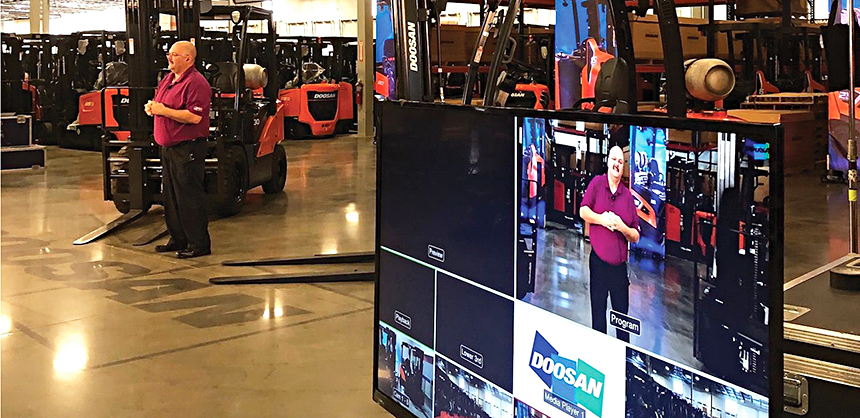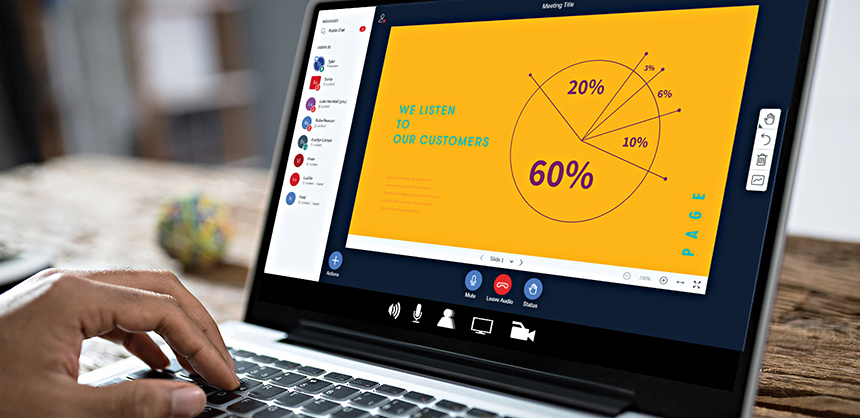Tips For Boosting Attendance At Virtual MeetingsNovember 30, 2020
By Christine LoomisTips For Boosting Attendance At Virtual Meetings

Simplify, simplify, simplify.
That’s the mantra planners should use as they create hybrid or wholly virtual events. Experts point to complexity as a prime barrier to registration in virtual meetings. “The registration process should be simple and instant,” says Barbara Connell, CAE, CMP, chief executive officer of the American Society for Gastrointestinal Endoscopy and chair of the Event Industry Council’s CMP Governance Commission. “No need to make it difficult.”
William Fogler, owner and principal of WM Events in Atlanta, Georgia, agrees. “Remove as many barriers to entry as possible. Keep registration simple and clear. Limit the number of platforms and systems you use. Offer dial-in options for guests with visual impairments. The less work, aka clicks, a guest has to make to enter your virtual event, the better.”
Brad Langley, CITE, MBA, vice president of channel and enterprise sales with Aventri, a meeting- and event-management solutions company, says he hears today’s planners lament that converting to a virtual format has been a real challenge. But it shouldn’t be that way. “Complex solutions won’t cut it, especially in a tough economy when planning teams are working with reduced resources,” he says. “Modern, all-in-one platforms streamline the process for organizers and attendees. They take all the data for an in-person event — content, sessions, speakers, marketing and registration information, etc. — and deliver it seamlessly in a virtual format. Planners can convert to digital simply by checking an ‘enable virtual event’ box.”
The Benefits of Virtual
Although virtual events are sometimes viewed as “less than” traditional events, hybrid and virtual conferences offer some benefits in-person meetings don’t. “Virtual events allow the individuals or companies hosting them to reach a wider audience,” says Greg Ellis, COO of Dacast, an online video platform company. “In general, virtual events are also less costly to produce. Event planners don’t have to book a giant venue or hire temporary staff, cater F&B, etc. These cost savings can be passed on to virtual attendees in the form of lower ticket prices.”
That’s a win-win for all. In the same vein, Ellis notes, “A recording that can be edited and uploaded later for will allow your content to continue performing at its maximum capacity and reach potentially new audiences that may not have been able to view your presentation in real time. However,” he adds, “an archival copy is key as it also allows you to reorganize the clips based on performance and remove any potential hiccups, such as the infamous Zoom-bombers.”
One of the biggest benefits is the opportunity to easily repurpose content. Ellis points out that after planners record and stream conference content to virtual attendees, they can also use those sessions as marketing materials. While Connell thinks in-person events are still preferable in terms of networking, ideas exchange and quality communication, she says the benefits of extending an event into the virtual realm are many. “Virtual events offer immediate access, no matter where they’re located,” Connell says. “They also provide attendees the ability to engage without travel or extra cost. They can bring in those who otherwise couldn’t attend, and keep the event conversation going online, allowing more people to make use of it well after the event.”
Like others, Connell stresses that on-demand access is the key to extending educational content and engagement beyond the event. “It allows the host to continue to offer quality education for an extended period. We’ve all seen reruns of our favorite shows; this serves the same purpose if you market it correctly. Finally, having enduring materials allows sponsors to extend their support of the program, share their message and align with the host for a longer period.”
Fogler sees the same positives. “Virtual events give us the unique ability to interact with others without being in the same physical space. They’re also practically impervious to weather, so your outdoor networking event can still go on. Virtual events can last a lot longer than in-person events because you’re not dependent on the cost or logistics of loading in and out of a meeting space. With the ability to record the meeting, guests can watch content later that day or even months later.”
As a longtime planner of hybrid events, Fogler says he’s a huge proponent of broadcasting a live feed to broaden the reach. “That can also generate additional revenue streams. Perhaps 500 people paid a premium price for the in-person ticket, but 2,000 may pay a smaller price to hear the same content virtually. Hosting recorded video streams can even encourage guests to attend in years to come.”
Like Connell, Langley says in-person events are best for some things. “People attend in-person events for education, networking and business development. For all these goals, nothing beats the power of meeting face-to-face.” Still, he continues, virtual solutions have distinct benefits. He names expansion of audience, including on a global level, as one. And like other experts, he points to the importance of creating on-demand content. “Meeting professionals can make content available on demand through digital libraries and continuing-education stores. In this way, virtual events create new revenue streams and keep audiences coming back,” he says. “And the rich data that events provide are easier to capture when events are online.”
Moreover, in a challenging economy, Langley notes, ROI is more important than ever, and a virtual event makes data easy to track. “Modern virtual-event platforms have robust reporting capabilities to measure ROI,” he says.
Among the things that can be tracked:
• How many people attended, where they came from, how they paid
• How long attendees watched sponsor sessions
• How delegates engaged
and how often
• Number of virtual booth visits, demos, video meetings, leads captured, shares, and downloads
• Languages, industries, geographical locations and more
Data, Langley adds, is a way to determine what works or doesn’t work, what engages attendees and what doesn’t. “Meeting professionals can take advantage of the analytics at their disposal and use this business intelligence to inform future events and marketing strategy,” he adds.

William Fogler, owner and principal of WM Events, has been planning virtual meetings for years. He says it’s important to choose the right platform for the type of virtual meeting being planned, as that can make the difference as to how many attendees will register.
The Basics
So what’s the best way to better attract attendees? In addition to simplifying, Fogler suggests that organizers do two other things to boost attendance. “Offer incentives,” he says. “High-profile speakers, prizes, coupons, networking opportunities, education and exciting entertainment are the same reasons we go to in-person events. Some platforms offer early access to schedule networking meetings with like-minded individuals. And,” he adds, “planners should invest in branding, especially for cross-platform marketing. Social-media posts, printed collateral and email newsletters should all be extremely eye-catching and cohesive. Offering Snapchat stickers or photo booth frames for guests to interact with beforehand drives awareness to untapped audiences.”
Don’t forget the title. “Develop a compelling title that conveys the content and value of the meeting,” Connell advises. “And engage participants with current content and relevance, as well as important presenters. If possible, offer educational credit and do it for free or at a greatly reduced rate.”
Education is a critical element of many meetings, and virtual formats lend themselves to engaging education sessions — when done correctly. “Using video or visual elements other than a talking head is always an advantage and provides a connection to content that otherwise may be lost,” Connell says. “Engaging participants in a responsive fashion is an excellent way to keep them engaged. Use a poll or question to gauge audience response to a question or situation. Use videos, especially when conveying technical or medical content, to better share concepts or results. Avoid presenting only verbal content.”
Ellis has four suggestions for boosting attendance, starting with counteracting potential distractions. “Your audience is in a high-distraction environment where going through email is the least of those distractions,” he says, noting that surveys, chat functions and engagement prompts throughout an event encourage attendees to be present. “During the event, be sure to interact with the audience with polling, social channels (i.e., Twitter hashtags) and live Q&A. There are a number of low-cost professional chat applications you can use to keep engagement up,” he says. “Lastly, ensure that the call to action fits the event and that follow-up is available.”
Event promotion is also critical. “The old saying, ‘Build it and they will come’, typically doesn’t yield great results, especially when you’re relying on virtual attendance,” Ellis says. “Determine who your target market is, the best promotional channels to your event and the timing of your promotion. Don’t forget to send prior-day and day-of reminders to registered users reminding them to attend. If you can, include an option for attendees to add a calendar reminder when they R.S.V.P., it’ll increase attendance rate.” He also says organizers shouldn’t worry about cannibalizing their live registrations. “You’ll need to market both events, giving registrants the option to attend either. In the end, you’ll have a happier base of attendees. Taking this a step farther, event promoters of annual conferences often create a hype-reel of live content from previous events to add interest and anticipation during the registration drive for current live and livestream events.”
Leveraging the power of speakers is another important strategy. “Many events have one or more speakers serving in keynote addresses. By providing a highlight reel featuring such speakers, you can leverage their draw-power to drive your own attendance,” Ellis adds.
Even with great speakers and compelling content, however, Langley says attendees may not want to sit through a full-day virtual conference. “Select your best content and break it into bite-sized pieces of no more than one hour. Then, invite attendees to consume information in real time or on demand through a digital library.”
Like others, Langley thinks an interactive element is key to attracting attendees. “Avoid top-down, webinar-style presentations. Encourage attendees to interact with speakers via Q&As and live forums. Run polls and surveys to help speakers tailor sessions to audience needs. You can also spike interest with fun, gamified challenges, and award prizes to keep sessions interactive and lively. Many virtual platforms enable live video breakouts and roundtable workshops,” he adds. “Let surveys help you customize topics for different attendee groups. Choose experts as moderators to encourage participation and keep discussions on target.”
As many experts point out, networking is a prime reason to attend a meeting, including virtual events. “Mix education sessions with virtual networking opportunities,” Langley suggests. “Bring participants together through dedicated chat feeds, social networking and live, one-on-one video conversations. Platforms equipped with artificial intelligence enhance networking by recommending other participants to meet based on shared interests.” To help with all of the above, Langley advises organizers to augment the tech capabilities they already have in place. “If you’re using a mobile event app for surveys, add features like chat functions, networking lounges, gamification, match-making, meeting scheduling and social feeds to encourage virtual networking,” he says. “You can start building interest ahead of time and keep attendees engaged long after your live event concludes.”

Experts all agree that the No. 1 way to boost attendance at virtual meetings is to keep every aspect of the event as simple as possible. Photo Courtesy of Brad Langley
Know Your Audience
While most experts don’t believe generational differences significantly impact the success of a virtual conference, they do say comfort and familiarity with technology is a factor. Planners need to think ahead of all the potential problems attendees might face that can impact attendance. “Having staff via help line, chat box or text message to navigate those issues is key,” Fogler says. “Clearly communicating agendas, links, updates and announcements is all part of the process, and limiting the number of platforms and instructions is important to avoid confusion. Younger attendees,” he notes, “are more likely to have certain apps such as Slack or Instagram on their phone already, so if you plan to communicate via a particular app during your virtual event, make sure you give ample time for guests to download and become familiar with it.”
Connell says success can be thwarted at any age. “Having to push too many buttons or click too many links can make it problematic for those who are working with differing devices or platforms. Most systems have become very easy over the past months, but there are still some that require multiple sign-in thresholds. You’ll lose your audience quickly that way, no matter what the age.”
Ellis also points back to simplicity. “Age only matters when it comes to the level of detail required for giving instructions. If the audience is post-university, consider a test page for them to check out instructions in advance, as some may not be as savvy with technology or have the know-how to shift between gallery view vs. presenter view, unmute themselves or how to turn a camera on and off. Those things may feel simple to a millennial, but can be challenging for someone who doesn’t use the technology on a daily basis.”
One way to avoid issues is to match the technology to the audience. “Like any technology, virtual-event platforms come with all the bells and whistles,” Langley says. “The important thing is to tailor the technology to your attendees’ ability to consume it. Participants like a simple, clean and high-quality production. Choose a platform that delivers on these priorities.
Looking to the Future
No one believes virtual events are going to disappear when the pandemic ends. There have always been potential attendees who couldn’t travel at the particular time of an event, and COVID-19 has made clear it’s possible to bring that audience into a meeting via technology, even if other attendees are convening in person. “For those who can’t travel for whatever reason, a virtual component can bring the content to them no matter where they reside,” Connell notes.
“Given the advantages,” Langley says, “I believe hybrid is the future of events. In fact, 91% of global event organizers say virtual will remain critical post-pandemic, according to a global customer survey Aventri conducted earlier this year. Organizers plan to incorporate virtual elements into their long-term strategy as a way to expand audience reach, provide new sponsorship opportunities and reduce risk. If an emergency arises and people can’t meet face-to-face, planners want a backup plan that enables them to be ready to go with a virtual event.”
Langley says research indicates that when face-to-face meetings return, “Virtual will no longer be an afterthought. Digital elements will be fundamental to face-to-face gatherings. The in-person event will become more valuable because it’s supported by a rich virtual experience.”
This is all the more reason for planners to know now how to best produce virtual events and attract attendees. “Talk to colleagues who’ve been successful and unsuccessful; find out what they did right and wrong,” Connell advises. “What would they do differently?” She cautions against planning too many programs. “You could wear out your audience and cause them to become tired of you/your message. That said, if you have relevant content that can keep participants engaged, plan all you can. Keep it succinct, current, filled with value and affordable,” she says.
Ellis reminds planners of a quick but critical step before sessions start. “Make sure attendees are muted when they first join. If not, users will feel compelled, sometimes obligated, to make small talk while waiting for other attendees to arrive. It creates an immediate distraction and holds up the start of your event; your one-hour meeting is suddenly cut down to 45 minutes.”
Fogler stresses that it’s important to understand clients’ needs before committing to a particular platform. “There are many options for hosting virtual events but they’re not all created equal. Some have great networking capabilities while others offer better back-of-house support. Some are priced per attendee, some by a flat fee. Think about how you can mitigate any less-than-ideal circumstances beforehand,” he says. “That may include relying less on live streams and more on pre-recorded videos, or helping speakers choose an ideal spot for their background.”
And don’t wait too late, Fogler cautions. “It’s easy to think that because you don’t have to load 500 chairs into a ballroom or rig truss from the ceiling that you can just send out a link and it will all work. In a lot of ways, planning a virtual event can take just as much work as a multi-day, in-person conference. It’s important to have rehearsals, test runs, contingency plans and tech walkthroughs to make sure everyone is on the same page.”
Like Fogler, Langley emphasizes using the right tools for specific goals. First, he says, “Prioritize event goals. Do you want to educate employees, drive revenue, build community around your brand? Prioritizing goals helps clarify the capabilities you need. Modern platforms offer a broad set of capabilities for different goals; choose features that will help you achieve your goals.”
For example, he says, organizers should leverage keyword search options to make it easy for the audience to engage with relevant content in on-demand education sessions. And then there’s monetization.
“Create a virtual exhibit hall with live chat lobbies to deliver an immersive showroom experience with demos and real-time one-on-one video conversations. Organize your events into libraries and allow viewership to target audiences. You can invite people to purchase sessions or entire conferences. Offer individual as well as bulk packages, enabling organizations to offer your content to their employees.”
Finally, he says, “Remain confident. This pandemic is challenging, for sure. But stay calm and draw on the knowledge and talents you’ve used throughout your career. This same skillset will help you succeed with your virtual event as well.” | AC&F |










